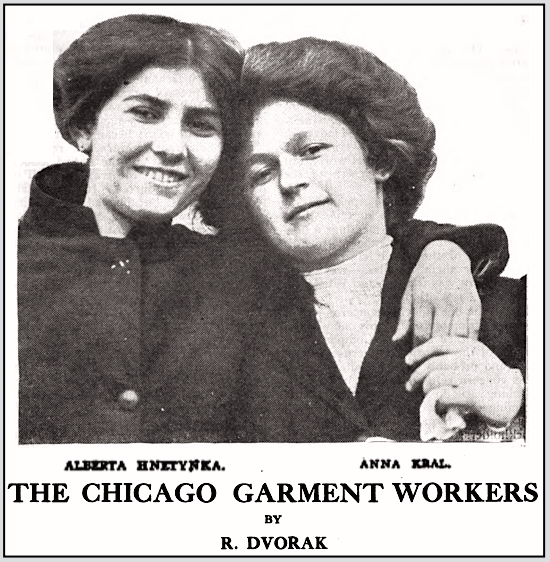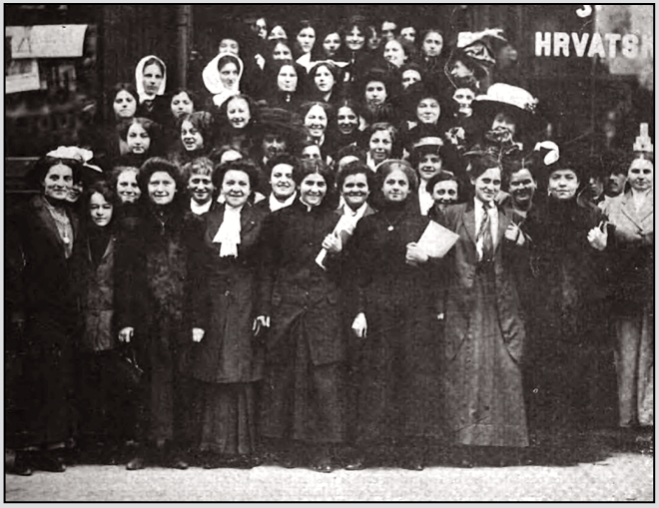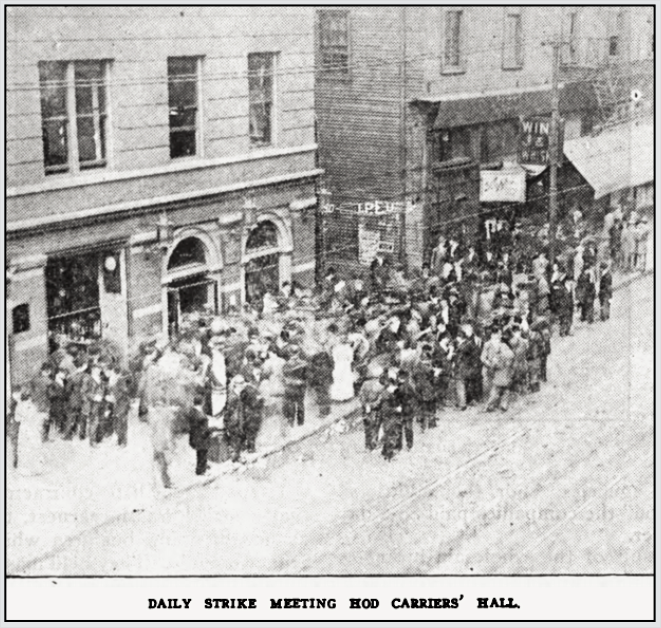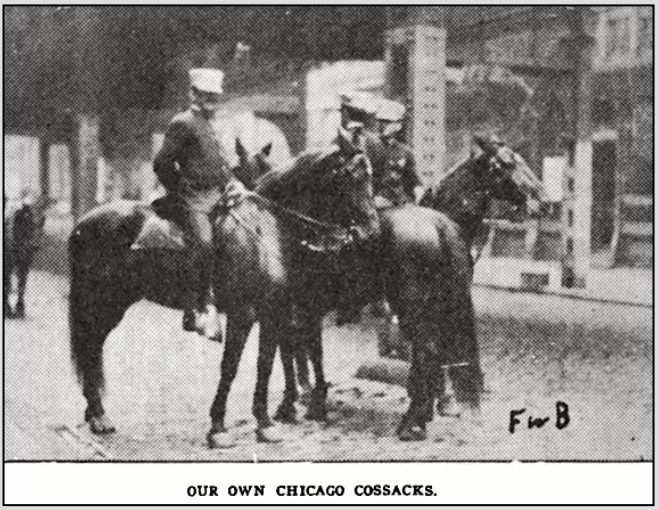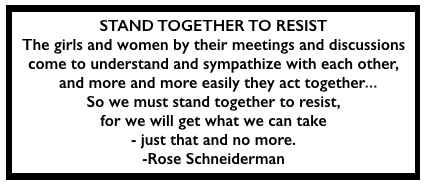 ———-
———-
Hellraisers Journal – Saturday December 3, 1910
Chicago, Illinois – Report on Strike of 41,000 Garment Workers, Part II
From the International Socialist Review of December 1910:
[Part II.]
Not satisfied with cutting the rates and wages of the tailors, the firm instituted a system whereby the employes were charged from five to fifteen dollars for the least damage done to a garment. Lost spools, bobbins and other implements were charged up to the workers and taken out of their wages.
During the slack months, the piece workers were forced to report for work. They sat around in the shops, work or no work, earning no money, but stifling in the close, dust laden atmosphere of the fabric smelling shops.
When the pre-season months, those that constitute the busy time in the clothing industry, arrived, things changed as if by magic. Every employe was driven at top speed. Girls who had worked late into the night at home, threading needles or doing other work in order to make more money and sidestep the ten-hour law, came down to work next morning almost ill. None, however, were ever allowed to go home when sick.
Girls who asked permission to go home when sick were given some powders—good for every ailment from an earache to a sick stomach. If these powders failed to cure and the girl fainted, as happened several times each day, a doctor was summoned. But never, under any circumstances, was a girl or boy given permission to go home when sick, at least not until more substantial evidence than a sickly appearance or a mere statement was given.
The fine, or charge system, instituted in the shops was the most abominable possible and was the basis of most of the grievances since listed by the strikers. Every employe was forced to punch the time clock three times a day. Failure to punch the clock cost the employe 25 cents.
Work in the shops began at seven thirty. The clocks had to be punched five minutes before the starting time and the punchers be upstairs at their respective places ready to work. If any of the employes punched the clock one minute late, he or she was “docked” fifteen minutes’ time.
In order to avoid being “docked” the employes had to be down at the shops at least fifteen minutes before starting time. Some came even earlier. This was just what the company wanted. As long as the workers came down earlier there was no need of putting in extra elevators and clocks.
The cutters suffered as many indignities as did the tailors. Fifty cents was being paid the cutters for the cutting of one suit. They were not supposed to cut more, but the foreman piled up the goods four and five layers high and made the price rate read, 50 cents for one cut. In this way the cutters made five garments ready for the tailors for the price of one.
Less goods was given the cutters to cut from. The inch of goods given extra, above the size required for a suit, was taken off and the cutters forced to spend more time matching the goods in color and stripe.
If a presser even slightly clouded the garment with his iron he was charged the full price of it. When the cutter even slightly cut into the garment line of the goods he was charged the full price of the coat or pants.
In one instance where a poor tailor, receiving fourteen dollars a week, slightly damaged three pair of pants, the company charged him $12. He had a family and could not afford to lose almost a whole week’s pay. The employes took up a collection and later raffled the trousers off among themselves. There was no harm done them and the winner is wearing them in public every day.
It was such petty persecution by the foremen and cutting in pay that finally brought the great revolt. It came when a foreman attempted to make a forelady from one of the speediest girls in his shop.
The girl had no objection to being a forelady, but she did refuse to accede to the bonus system offered her by her boss. She would not listen to a cutting of the piece work rate of the girls in the shop and absolutely refused to ask them to work at home. She rebelled and finally threw the job at the feet of the boss. This girl was persecuted from that time on.
One day sixteen of the girls in the shop felt ready to “do or die.” The leaders, Clara Massallotti, Bessie Albramovitch [Abramowitz], Rosie [Annie] Shapiro, had the girls well in hand. Clara Massallotti, only 17 years old, came to the boss and told him that she had enough of the persecution. He laughed at her and told her to go back to work. They argued back and forth until the girl pulled out a little whistle. Before the boss could stop her she had blown it.
Sixteen hands dropped their work. Sixteen aprons went off as one and sixteen girls put on their wraps and left the shop. The boss raved, argued, threatened and entreated. His voice fell on deaf ears. The girls walked out of the building determined to enter it never again until better conditions had been established.
With tears in their eyes the girls walked into the office of Robert Noren, president of district council N0. 6 of the United Garment Workers, 275 La Salle street. To him they told their story. He listened patiently and saw that there was a good chance of striking for a union. He telegraphed his opinion to New York.
The sixteen girls did not remain idle. They went to the other shops and told their story. The result was that the next day almost a thousand girls were on strike in the various shops. They told other girls and before the week was over 2,000 girls were walking the streets of Chicago, blowing whistles and calling others to their aid.
Then came a telegram from New York, and with it word from T. A. Rickert, International President, authorizing a strike of the garment workers. President Noren took immediate action and the thousands of tailors who had been waiting impatiently for such an order, walked out. Before the strike had lasted three weeks 41, 000 garment workers had left the shop.
Meanwhile the manufacturers had not been idle. A call was sent into the police headquarters. The police, as has been their habit for years, responded willingly. Foot and mounted policemen were assigned to strike duty and persons who dared to stop near any of the strike bound shops did so at the risk of broken heads or ribs.
Not satisfied, the strike bound concerns hired private sluggers from the McGuire and White and the Mooney and Boland detective agencies. For this additional “protection” the companies paid $8 a day per slugger.
The result of the wholesale hiring of “protection” was a riot in every part of the city each day. Strikers heads, and even those of people not interested in the struggle, were broken on a wholesale basis each day with clubs and revolver butts, As many as 40 persons were arrested at one time, on their way home from a mass meeting.
At least three girls were brutally clubbed in the streets for daring to reprimand policemen for their brutality. One girl, Stazie Kunes, received a smash from one policeman, number 2453 from the Hinman station, which crushed her lower jaw and broke her teeth.
Hundreds of cases of brutality could be listed in the seven weeks of the strike. Over 275 persons were arrested. Nearly 50 were beaten so bad that they had to receive medical treatment. At least ten of the strikers have been in bed ever since the first week of the strike.
The brutality of the police and sluggers hired by the strike-bound concerns aided the strikers in one respect. It secured them the sympathy of the public and many influential persons. Now the strikers have determined to never go back to work until the firms agree to recognize the union.
As soon as the little contractors realized that a strike was in earnest, they saw a chance of doing business while the big firms were idle. They held mass meetings in their various localities and voted to stick with the strikers. They unionized their shops by signing up with the union and began to manufacture clothing as fast as the shop forces would allow.
Many of the small tailors even went so far as to secure financial aid for the striking garment workers and urged the various business men in their neighborhoods to do the same. They did this with the hope that Hart, Schaffner and Marx would be defeated and would be forced to unionize its shops.
The union, from the very first week of the strike, realized that all of its energy had to be directed against Hart, Schaffner and Marx. It realized that the big concern was the leader. If it was unionized the others would soon follow. Therefore, all forces at the present time and throughout the strike have been looking to Hart, Schaffner and Marx and its forty-eight shops. The other 100 or more strike-bound concerns are practically ignored. They are the fringe hanging unto the main garment—Hart, Schaffner and Marx.
While the little fellow is lining up with the strikers in the fight, the Clothiers’ Association is forced to line up with the Hart, Schaffner and Marx concern, but it is lining up shrewdly, realizing that sooner or later the renegade will have to enter the association, secretly, however, hoping that it will be wiped out of the field of competition.
———-
[Emphasis added.]
~~~~~~~~~~~~~~~~~~~~~~
SOURCES & IMAGES
Rose Schneiderman Quote, Stand Together to Resist Mar 20,
-NY Independent p938, Apr 1905
https://babel.hathitrust.org/cgi/pt?id=coo.31924106546991&view=2up&seq=962
The International Socialist Review, Volume 11
(Chicago, Illinois)
July 1910-June 1911
https://www.marxists.org/history/usa/pubs/isr/
https://books.google.com/books?id=8-05AQAAMAAJ
ISR-Dec 1910
https://www.marxists.org/history/usa/pubs/isr/v11n06-dec-1910-ISR-gog-Corn-OCR.pdf
https://play.google.com/books/reader?id=8-05AQAAMAAJ&printsec=frontcover&pg=GBS.PA320-IA3
-page 353: “The Chicago Garment Workers” by Robert Dvorak
https://play.google.com/books/reader?id=8-05AQAAMAAJ&printsec=frontcover&pg=GBS.PA353
-page 356: Part II
https://play.google.com/books/reader?id=8-05AQAAMAAJ&printsec=frontcover&pg=GBS.PA356
See also:
Hellraisers Journal – Friday December 2, 1910
Chicago, Illinois – Report on Strike of 41,000 Garment Workers, Part I
Tag: Chicago Garment Workers Strike of 1910
https://weneverforget.org/tag/chicago-garment-workers-strike-of-1910/
Bessie Abramowitz Hillman
https://en.wikipedia.org/wiki/Bessie_Abramowitz_Hillman
United Garment Workers of America
https://en.wikipedia.org/wiki/United_Garment_Workers_of_America
The Clothing Workers of Chicago, 1910-1922
[Sept 22, 1910 to Feb 18, 1911]
-by Leo Wolman, Paul Wander, H. K. Herwitz, Eleanor Mack,
Amalgamated Clothing Workers of America, Chicago, 1922
https://archive.org/details/clothingworkers00deptgoog/page/n8/mode/2up
https://catalog.hathitrust.org/Record/000953861
https://books.google.com/books?id=9TwuAAAAYAAJ
Chapter II-The Strike of 1910
(search separetly: Schapiro; Abramowitz)
https://play.google.com/books/reader?id=9TwuAAAAYAAJ&hl=en&pg=GBS.PA16
For more on Hannah “Annie” Shapiro/Schapiro:
Note: the 1922 ACWA Report above has her as “Annie Schapiro”
“September 22, [1910]: Teen prompts Chicago garment workers’ strike”
-with photo, sadly gives no source for photo so could not verify.
https://bestteenagersever.wordpress.com/2014/09/22/september-22-teen-prompts-chicago-garment-workers-strike/
Annie Shapiro and the Clothing Workers’ Strike
by Marlene Targ Brill
Millbrook Press, Oct 1, 2010
https://books.google.com/books?id=CJc-zMqyUlAC
“Guest Blog: Marlene Targ Brill on Annie Shapiro and the Clothing Workers’ Strike”
https://lernerbooks.blog/2010/10/guest-blog-marlene-targ-brill-on-annie-shaprio-and-the-clothing-workers-strike.html
~~~~~~~~~~~~~~~~~~~~~~~~~~~~~~~~~~~~~~~~~~~~~
Union Maid – Old Crow Medicine Show
Lyrics by Woody Guthrie

